Archive for category Jan Brett Posts
November 2013 Hedge a gram All About CINDERS a Chicken Cinderella
Posted by Jan Brett in Jan Brett Posts on November 6, 2013
October 2013 Hedge a gram
Posted by Jan Brett in Jan Brett Posts on October 3, 2013
Happy October!
I’d like to tell you all about the children’s book I’ve been working on. It is called the Animal’s Santa, and it tells the story of a snowshoe rabbit that is very sceptical about Santa. His older brother knows that the forest animals are receiving presents on Christmas morning, and he wants his little brother to join in the fun of Christmas. He is pretty sure that Santa is leaving the presents, but he just doesn’t have any proof. My story is how he traps Santa.
I set my story in North America, in the north of Canada, because it seemed possible that the animal’s story could take place there. The animals that live in the North woods are somewhat reclusive and mysterious. There is an Artic Fox vixen, Raven twins, a Porcupine and the Snowshoe Hare brothers. A Polar Bear, Moose and Badger also make appearances when the animals describe who they think Santa might be.
I’ve worked on my book for many months now, and its beginning to have a momentum of its own. I start with a dummy, or cartoon version that is 32 pages, the same length as the book will be, so I can refer to it, but I always wait for that moment when the story starts rolling along. The sketches serve as a road map, but I try not to let them get in the way of new ideas that crop up.
When I lived in Boston as an art student and a young mother, I spent many days at the Peabody Museum at Harvard. My young daughter and I spent hours looking at the taxidermied animal specimens that had been collected from all over the world. The museum also has an extensive collection of Native American arts and crafts, and it cast a spell on me. I was very intrigued with the porcupine quill work. One of the reasons I set my book in North America was so I could paint quill work in the borders. I didn’t copy any of the quill work from the museum, but tried to imagine the forest family in my book as an undiscovered native people, with their own esthetic. Most of the materials I used are typical of the materials used by First Peoples.
Today I’ll be working on my book’s jacket. My editor and I have been giving a lot of thought on what the title should be. We both love “Who is the Animal’s Santa?” But it takes up a lot of room on the jacket, and restricts the art. The publisher is afraid there will be confusion about the title, and people won’t remember the title. So right now the title is “The Animal’s Santa” I show the question being asked in the body language of the main character, “Little Snow”.
I just received my authors copies of “Cinders”, about three weeks before the publisher’s release. I am just thrilled with the way it is presented. It is a wintery fairy tale, and there are subtle sparkles on the jacket, and on the display type. Marikka, a very talented designer at G.P.Putnam’s Sons (Penguin) created an extraordinary jacket. Not wanting “Cinders” to look like one of the more commercial offerings, she added copper foil to embellish my name, which is a bold choice when paired with the ombre pink and white lettering of the display type. The effect is very nuanced and ethereal, and represents the kind of subtlety that children can appreciate when they are exposed to it. As electronic games and movies become more available, children’s books are becoming more defined. They seem to have the potential to fully realize the human imagination in a very personal and intimate way.
I am looking out my window into a beautiful early fall landscape, but even more real to me at this moment, is the winter palace peopled by gorgeous poultry in their finery, and my north woods tribe of animals, in their snowy woods. Maybe now is the time for you to realize a complex world of your own making. It’s an exercise puzzle in creativity and discovery that leads to unexpected places.
Happy Creating,
Jan Brett
September 2013 Hedge a gram
Posted by Jan Brett in Jan Brett Posts on September 2, 2013
Happy September,
This is Jan Brett telling you about what’s happening in my life as an author-illustrator of children’s books.
I am halfway through my 2014 picture book,WHO IS THE ANIMAL’S SANTA? I love working on the finishes, and embellishing my original ideas and adjusting the text to enhance the story. It’s probably my favorite part of the process. The art takes a long time, and there are many steps backward when I decide to change the character or adjust the color of the skies for example. There’s a great deal of pressure from the publisher to get my book finished in a timely manner, but I don’t want to rush and miss an opportunity to make the book better with a different image idea.
My book is set in northern Canada, and the animals show the winter coats for which they are known – the Arctic Fox, Lynx, and Snowshoe Rabbit especially. In my book the animals exist in a tribe culture and their natural predator-prey relationship is suspended – it being Christmas! I wanted a neutral element to construct my borders like the Birch bark in THE MITTEN and HOME FOR CHRISTMAS and I chose quillwork, a native American, or first people’s art that uses porcupine quill’s to create designs on clothing and ornaments. I have collected quillwork boxes over the years, because of their beauty, and have designs of feathers, a great blue heron, chickadees, of beaver, a star and the four directions. When I researched these designs, I was struck by how the art of the first peoples is often story driven and how the image contains a strength focused from the artist’s mind. I’ve always loved stories and storytelling and it’s not only my job, but is the way I stay connected with my humanness. I love to think that generations before me created images that gave them beauty and significance and how they have lasted for hundreds and even thousands of years. I’m about to visit my granddaughter in Japan where she lives, and I’m already thinking of stories to have on the ready when she asks. Some of them are from my childhood and I love to think she is included in the family’s history by knowing them. Like the time Madame our cat stowed away on our sailboat, the time we were not allowed to swim off the boat in the ocean and then two huge fins swam by. The time I ran away, because I didn’t want a splinter taken out and got into big trouble. The time Richard our golden retriever brought home a wallet and money blew all over our backyard. Now that my granddaughter’s four, I’m hoping she’ll have some stories for me. When my daughter was growing up we had a read aloud time every night, even until she was in junior high school. I remember WATERSHIP DOWN, GONE WITH THE WIND, and M.A.S.H. as being great favorites. Communication between us was meager during that time, and books were great life-raft for informal chats.
My sisters are a little dubious about my stories, and I admit a good story takes precedence over the facts. I would even go so far as to say sometimes a story takes on a life of its own, and the teller goes along for the ride. Our minds are complex and rich and we never fully aware of what they’re capable of sending out.
Happy creating,
Your friend, Jan Brett
August Hedge a gram
Posted by Jan Brett in Jan Brett Posts on August 6, 2013
Happy August,
This is Jan Brett, and this is my August hedge a gram – the time I take on the first day of each month to keep in touch with friends about my children’s books.
There are many aspects of my profession that I’m enthusiastic about doing, but none so much as painting away on the final pieces. The book starts as an idea that I discuss first with my husband Joe and then with my long time editor, Margaret. Come to think of it, my husband is long time too! Joe is a musician by background, and is familiar with the creative arts. He gives me a practical opinion and is very familiar with all my other books. Margaret is a towering talent, who really understands how a book unfolds.
Sometimes a book sketch will change and morph into quite a different story than my original idea. Last summer at about this time, on a hot night, the idea of an animal’s Santa sprang into my head with no warning. It was a big surprise. My idea was to describe in a poetic way how a Snowy Owl Santa would bring presents to the animals in the wild woods. The owl has long been associated with mystery, knowledge and human-like roles in stories. Its large eyes placed on the front of its head and its beautiful plumage have made it a marvelous creature to draw. The snowy owl nests in Arctic regions, and then some travel quite far South in winter. We have a population that frequent Logan Airport in Boston, as well as the beaches of Cape Cod. They’ve always fascinated me. The snowy owl seem to be just waiting to become a Santa character. I knew owl’s feathers have a soft leading edge that enables them to fly without sound and that furthered my inclination to make him the animal’s Santa. I e-mailed late at night my longish poem to Margaret the same night it came to me. The next morning she wrote back that she loved the idea and she has questions. That is Margaret’s nice way of saying that she thinks the story could be developed more. In all honesty, I felt my story was ready to go so I had to settle my thoughts and think about it. For several weeks I would turn over the story in my mind choosing certain characters to have expanded roles. I needed to create more in the story line department and give the book some emotion and tension. I’ve always been excited about how the common element H2O, water, has transformative powers. It can be a gas, a liquid, or a solid. I remember a story I read about a boy escaping pursuers across a huge frozen lake because he was the only one with skates. The Inuit built tall towers out of rock by using snow to lift them to higher levels as they placed rock upon rock as the snow got deeper. I decided to make use of the fact that ice can produce a tone when hit to make a chime. That would be how the animals would discover who the animal’s Santa could be. They set a trap for him, with warning bells made of ice, so they could see for themselves who was leaving presents.
As a child I remembered being in the upstairs bedroom I shared with my sister straining to hear the sound of reindeer hooves on the roof or maybe reindeer bells. All those years ago people didn’t have snow tires, so to create traction on the snowy streets they put special chains on their tires. The chains made a pleasant jingly sound, especially late at night when the lone car drove past. I’m sure I wasn’t the only child who heard the jingle and thought “reindeer”!!
As I worked on my manuscript I really felt like I was just going through the motions until finally the story became something else. I don’t like to admit it took another person to push me, but that’s what happened on this book. I am grateful to work with an editor who I can trust. Now, that the hardest part is done, I can enjoy painting the illustrations.
If you’re working on a creative project you know it is hard to juggle your ideas and be open to constructive criticism too. The important thing is the goal of a good book, and to me that’s the important goal.
Happy reading and happy creating,
July 2013 Hedge a gram
Posted by Jan Brett in Jan Brett Posts on July 10, 2013
CINDERS, a chicken Cinderella
Happy July,
This is Jan Brett, and this is my July Hedge a gram – my monthly update on my work as an author illustrator. I often reflect on how lucky I am to wake up in the morning and look forward to work on my illustrations and book ideas. At the same time, I’m keenly aware that others enabled me to live and be productive the United States. July is marked with our country’s July 4th celebration, and for me it is time to thank all of the men and women, and their families, in the United States military. I know personally many members of the military and I’m particularly grateful for their dedication.
I am hard at work on THE ANIMAL’S SANTA. Every book evolves differently, and this book started as an ethereal description of who the animal’s Santa could be. It was poetic and simple. My editor suggested that I focus on the story behind my idea, that I form characters and put a little tension in the words by creating more of a story line. At the time it seemed a momentous task but to my surprise the story line just appeared. Sometimes a book will appear in my mind almost fully formed, or in the case of the retelling, like this year’s book CINDERS, the creativity was in taking a historical tale and putting in new characters and setting. When I come up with an idea myself I’m exploring, and I have to be ready with an open mind to get my story just right. In most of my books a great source of inspiration comes from travel. I usually decide on the setting, and then travel with my book dummy in hand, collecting costumes, architecture, flora and fauna, in a part of the world that fascinates me. I visited a school several years ago in Newfoundland, and I was very taken by the people and culture. For THE THREE SNOW BEARS a book published in 2007, I was in Canada in Baffin Island. Once I had sketched out the ANIMAL’S SANTA, I wanted to set it in the boreal forest of Canada a belt of wooded wilderness, very thinly populated by people that felt unspoiled. It seemed like a place my story could unfold, and I relied on my experiences in Canada for inspiration.
When I illustrate my books, I decorate the borders with folk art, or natural elements of the setting. I love birch bark with its pale color whorls of moss, and dark markings, but I used birch bark in THE MITTEN and HOME FOR CHRISTMAS. One thing you never want to ask an artist to do is copy oneself! Strangely, the fascination of painting something new and intriguing has an exhilarating effect I think it adds a magical ingredient for the illustrator. When I go to Canada, I try and seek out native American’s arts. It started with a small box made of native porcupine quill. I find the embroidery fashioned from the flatened quill beautiful. The colors are nuanced and the texture wonderful to touch. Only a very few Native Americans are doing this work today. They’re carrying on a tradition that goes back hundreds of years. The borders on my book are my version of this kind of embroidery. Rather than copy native American designs, I am following the craft but trying to search my own thoughts for the designs. In my reading about American Indian embroidery, the artist often say they dream about designs, so I am going to try it. The animals in the boreal forest are coincidentally animals I love to draw – Showshoe Hares, Arctic Fox, Lynx, Moose, and Wolf. Whenever I think of Christmas I set the scene at the North Pole. Although few animals live at the North Pole, I populated the mythical north pole with the animals of the boreal forest. When we went to Baffin Island, I was stunned to learn that nearest tall trees were 1,000 miles away. In my book, THE ANIMAL’S SANTA is a Snowy Owl, a bird that lives above the Arctic Circle. The elves are lemmings, and my cast of animal characters live further south, but still in the Canadian wilderness. These animals in the framework of my story are so isolated, they are untouched by notions of a commercial Christmas.
As I work through my story I am making one decision after another that will reveal the story to me. It sounds strange, but part of the fun of telling the story is when it turns the tables and takes charge, dictating the elements that tell the tale.
It is summer, and I hope that you can set some time aside to create your own story or pictures. It is something we humans have, the storytelling ability that tells us something about ourselves. In a way we can merge with beauty around us, and give freedom to the creativity that bursts out of us all in unexpected ways.
Happy creating,
Your friend, Jan
June 2013 Hedge a gram
Posted by Jan Brett in Jan Brett Posts on June 8, 2013
THE ANIMAL’S SANTA sketch page 28 and 29
Happy June,
This is Jan Brett and this is my June Hedge a gram. I stop everything once a month to tell about what is happening in my professional life as an author/illustrator. The BEA or Book Expo America is a big convention in New York City. The nation’s publishers present next year’s offerings to bookstores, libraries and book lovers. I was there thanks to my publisher Penguin and I saw bound copies of my fall 2013 book CINDERS, a chicken Cinderella for the first time. It looked classic but very ornamented, with special treatments on the jacket to make it stand out. My name is in a lovely copper foil, the display type for the title is in a raised, lightly textured pale sparkle ombre, the image of Cinders in her pumpkin sleigh pulled by Swedish Blue ducks is highlighted by a varnish which gives the image both depth, and lastly a jewel-like patina is added to Cinder’s ornaments. She’s in a fancy ball gown. The options for the jacket printing are ordered in advance and added during the printing. That means the full effect is only guess at. When I see the finished book it is very dramatic. I signed advance copies of the book which are given out for free at the Expo, and book lovers line up to receive an autographed copy. I’m even beginning to recognize some of the loyal BEA goers that stand in line every year.
At the publisher we spoke about our fall book tour which will last three weeks. Since the chickens are the main characters in this book, we had a great time imagining how fun it would be to have chicken owners across the country bring their feathered friends to the booksignings. However, the book store owners did not share our enthusiasm. My chickens are very docile and personable, but our bus is a very small space to share with chickens, and I would worry they would miss their coop where they have plenty of room to run around and perch at night.
My editor and I had a constructive meeting at the Standard Hotel before a party put on by our publisher, Penguin for authors, illustrators and booksellers. I have been working on my 2014 book, THE ANIMAL’S SANTA. I’ve completed the dummy, but a picture book is 32 pages and although I usually write for that amount of pages, this time I have one scene too many. We discussed which scene would be left out, and we will probably have to go back and rewrite part of the manuscript. I have a completed dummy, which is a smaller size book I sew together out of typing paper so I can visualize how the art will look in sequence, the way one would see a finished book. Not only does that problem have to be solved, but I was not happy about the border design. I have the “window” in the shape of an owl which gives a hint from page one about who the animal’s Santa is. In the past, the windows have been in the shapes of eggs, hearts, gingerbread cookies, mittens, and in the case of ON NOAH’S ARK in the shape of various animals. I like the owl windows, but I chose porcupine needlework as the background or to use the computer term, wallpaper. Because it is a native American handicraft that I love and collect I thought it would be perfect, but once painted in it looked drab, not beautiful and nuanced as it is in reality. I love the birch bark I used in THE MITTEN and HOME FOR CHRISTMAS, but I wanted to try something new. I’ll spend the next few days trying different solutions perhaps using knitted patterns that have a wonderful texture and are colorful and have a cozy feeling. I might also add some evergreens in the border, since the fragrance of balsam is so much a part of Christmas.
Once the book is finished and I see the beautiful bound copy, I sweep away all the challenges and disappointments I feel when creating the book, and revel in the world of creatures and folk crafts that form my new offering. Some books stall out during the writing, some take a long time for the characters to feel real, and this one may take extra time to iron out a perfect balance of narrative, in the big images and decorative flourishes in the borders. Although it is a Christmas book, I don’t want it to look like a Christmas card. It is children’s literature first and foremost.
Good luck with your creative projects, and join me in doing all that good problem-solving work that will hopefully produce a dynamic an artistic result.
Your friend, Jan
May 2013 Hedge a gram
Posted by Jan Brett in Jan Brett Posts on May 13, 2013
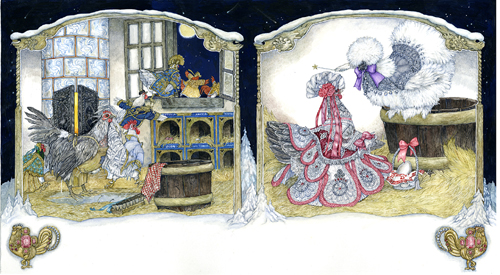
The Fairy Godmother arrives from CINDERS, a chicken Cinderella
Happy May,
Every month, I stop what I’m doing, and let kids and interested children’s book enthusiasts know what I’m doing, in the hopes it will help you with your creative projects, or just shed some light on how I go about creating a children’s picture book.
I say “creating” because I write and illustrate my books. The artwork is what really drives my interest, and has been the part of my job that really defines me. that is why I will sometimes retell a favorite folktale or fairy tale. Last year I illustrated Cinderella. Because I find chickens both beautiful and fascinating, I made them my main characters. Chickens, when living in medium sized flock of many ages and of both genders, with plenty of room to move around have many human like behaviors. They can be loving, or form best friends, they can get jealous, or bossy. In my flock there is a great amount of flirting and male solicitation at the moment, which escalates in spring. The mothers are very protective of their babies, and are very patient with them as they teach them to eat, drink and come when called. All their personalities went into my book characters, and it was great fun to observe them, and then paint what I saw.
When I first thought about illustrating Cinderella, I was resistant because tend to I shy away from stories that use magic or a rescuer to save the character. The more I got into the story though, I thought that the transformation of the bedraggled, unhappy girl into the blooming confident women, is a rite of passage that can happen to a lot young women . When viewed in that way I liked the story more.
It?s always difficult to say goodbye to my characters when I’ve finished my book, but I always make sure I have a another book idea waiting in the wings. Actually, more than one! Often I’ve talked to my trusted editor about these book ideas, and she will give me a go ahead.Last summer on a hot steamy night, I got an idea about the wild animals Santa. Where it came from I have no idea, especially since I usually do my creative thinking in the morning when I’m fresh. I was so excited about this story idea that I wrote it all down, as if I heard it before and without giving it another thought, emailed it to my editor. She liked it! I didn’t know it then, but there would be many drafts and much thought as I would turn over that initial idea trying to make it a complete story. My editor kept insisting that I keep pushing and carve out a satisfying story, and I finally did. I would have been terribly discouraged when I first wrote my piece if I had known how much more work I had to go. That’s what editors are for, and the best ones manage to make you work hard without feeling like it was a bad story to start with. The writer or artist is always vulnerable when the ideas are just forming.I think that’s why a lot of creative people don’t like to talk about their work until its near completion.
I spent a few weeks working on my 32 page dummy, a cartoonish, sketch version of my book, and then took it to NY to talk about it with my editor, Margaret. We finalized the trim size, which is how the dimensions of a book are described. Then, both of us edited out as many words as we could, now that we had the artwork to describe events. The things that can’t be painted, like the fragrance of fir trees, the feel of frosty cold air or the jingle jangle sound of broken ice will be described in the words. I?ll try to tell as much of the story as I can in the pictures.
Yesterday I started on my first double page spread, actual size. I experimented with different shapes in the borders, and played attention to what colors would be in my palette. Since my book takes place entirely outside in the snow I thought about the animals that I would cast as the friends of the two Snowshoe Hares that are the main characters. When Margaret and I met in NY we thought long and hard about what the animals would wear. It could be their natural fur coats, it could be just sweaters like what dogs wear, or they could have costumes that look like they were from another culture, either real, or imaginary. I like the thought that my job entails important decisions like, ?what the animals will wear!?
One of the reasons I chose Snowshoe Hares as characters is because of their amazing winter coats. They are brown in summer, which makes them blend in when they have babies. Then in fall, patches of white start appearing. By the time the world is white with snow, they are too, except for their ear tips which remain black. I’ve always thought that was the most surprising thing. There is a bird, the Ptarmigan that does the same thing.Its feathers go from brown in summer to white in the winter, except for black tips on their wings.I set my book in Scandinavia so I could include a hedgehog as one of the animal friends, just because I like hedgehogs. Hedgehogs don’t live in the Americas. I also put in surprise appearances of a badger, wolf and moose, other fun animals to draw. I have to save the best until last because of the way I’ve told my story. The animals are all guessing who the Animal?s Santa is, and they are wondering who has been leaving gifts on Christmas.It turns out that its a Snowy Owl. The Snowy Owl is the largest Owl in North America, and it also lives in Polar regions across the Atlantic. Its a fearsome predator of small furry animals, but because of the magic of Christmas he is benevolent. Curiously, the color, white, of its feathers and the way the feathers are arranged on its face, make the Snowy looks like a bird-Santa. You can imagine the feathers framing its face looking like a beard.
I’m looking forward to continuing to work on the finishes of my book, my favorite part of the process. Good luck with your story ideas, and don’t ignore that seemingly strange idea that pops up from who knows where. I might just be a future book.
Happy Spring,
Jan Brett
April 2013 Hedge a gram
Posted by Jan Brett in Jan Brett Posts on April 1, 2013
Happy April!
This is my April hedge a gram. Every month I take a breath to oversee what I’m doing artistically and write about it. In the past aspiring writers and illustrators, and especially children, have been curious about the steps it takes to create a book, and these Hedge a gram’s give a little insight on how it’s going.
This year, it’s been a rocky start. One hot summer night last year for no reason, I got an idea about an animal’s Santa. I love the traditions of Christmas because we use our imaginations and fancy. I’ve always been fascinated by snowy owls and the fact that they breed in the Arctic, and many fly south in winter, particularly to Boston’s Logan airport which is about 20 miles from us. Every time we fly out of Boston, I’m glued to the window trying to pick up a teeny blob of white as we taxi. So far, I’ve never seen a snowy owl, but because of their beauty and singular faces they are photographed a lot, and I enjoy seeing the images. They have an otherworldly gaze as if from a faraway place, and their white color and black rimmed yellow eyes give them a look of sorcerers. When I wrote my first draft of THE ANIMAL’S SANTA, I had the snowy owl in mind as Santa. It is a creature of the far North that is beautiful and mysterious. It travels south every winter and its white face reminds me of a Santa, even appearing to have a smile in some photos.
The first draft didn’t have enough substance, so I spent weeks trying to cobble together a storyline which could be receptive to my original idea of the mysterious visitation of the largest owl in North America from the Arctic.
I wasn’t getting any traction writing my story, so I switched to telling the story in pictures. This is unorthodox for me, because so far all my books have begun as manuscripts. I used all my usual techniques to try to puzzle the story together. I’ve been thinking about it while running, thinking about it while listening to music, and asking myself questions before falling asleep, hoping my unconscious mind will help me out.
When I was a little girl at Wilder Memorial nursery school in Hingham, Massachusetts, where I grew up, we made native American headbands, and we were able to choose a feather to have stapled to it. I was thrilled with the prospect and was enamored of a book I had at home at the time which described different Native American tribes, their art work and clothing. My grandfather fueled the flames of my interest by taking us for walks in the woods where we tried to walk like Native Americans, making no sound that would scare the animals. Our nursery school teacher had two huge bags of white turkey feathers. One bag held white feathers that had been dyed black at the tip to look like eagle feathers. The other bag had feathers dyed rainbow colors, including unusual ones I recognized from my crayon box of 200, like chartreuse, magenta, and turquoise. I was overwhelmed with the choice. Do I choose the more authentic eagle feather, that would look like the headdress in my book, or do I choose one of the vibrant colors that please the eye? Years later, I’m still grappling with that dilemma. I’m writing a book about the animal’s Santa. Does my cast were fascinating, elaborate clothes like out of the Hobbit? Or, do the animals wear just a nod to clothes, taken from Native American items I’ve seen in the Harvard Museum’s collection. Idea number one would be colorful and charming, idea number two would be perhaps more true to the spirit of my story. I’m working on both ideas at once, and will go to New York this month to work with my editor, but I’m drifting toward the same decision I made 59 years ago at nursery school, when I chose the “eagle” feather.
Creating a children’s book remains a mysterious process, and one that has highs and lows. The rewards are worth it, and never fail to amaze me.
Good luck with your creative projects, and don’t give up on your idea!
Happy Creating, your friend,
Jan Brett
March 2013 Hedge a gram
Posted by Jan Brett in Jan Brett Posts on March 2, 2013
Happy March!
This is Jan Brett with thoughts about my books. I am primarily an illustrator, but I like to write the story myself, or retell a familiar one, so that makes me an author/illustrator.
I’ve just finished the last piece of art for CINDERS, a chicken Cinderella which will be published in September 2013. I knew there would be a lot of detail in the chickens and in the ballroom costumes, and many characters on each page, but I underestimated the time it would take, and I spent November, December, January, and much of February working long hours to complete my year long project. I usually work every day, but the flexibility I get from working at home in combination with having one big deadline a year makes it easy to get behind. I think there may be another reason it is so hard to finish a book. I get to really like my characters and the combination of the setting, in this case Russia, and characters, in this case chickens I may never have a chance to paint again in book form. It’s hard to say goodbye, and I feel myself resisting sending the last piece of art in that will end it.
Luckily I can get started on a new book, and be energized by imagining a new world and characters. I’m struggling with getting a great storyline for my 2013 book, THE ANIMAL’S SANTA. Normally I get the manuscript in working order, to be approved by my trusted editor. This time though, she has many questions, which means the story isn’t really working for her. This gets difficult, because it’s hard to retrace one’s steps, then change things but still keep the original story idea. I’m taking a different tack and using illustrations to tell the story and see if I can get it right. Then I will go back to words and checking with my editor. It’s extremely difficult to plow through negativity, but I listen to my editor because she has very good ideas and instincts. Sometimes I’ll use the trick of solving problems by asking myself to fix something before I go to sleep, turning over the idea just as I’m nodding off. I think about the story when I run too. Not on a fast run or a race but on fun runs. Sometimes, the fresh air and oxygen flow will kick off an idea. My husband is a good judge, and he can give me a lot of useful input as well. It is very hard to know how much criticism to let in, because it taints the story, and then “pouf” you have nothing.
I recently heard Lang Lang a famous pianist perform. I was in the audience and was swept away with his interpretation of Rachmaninoff’s second piano Concerto. Afterwards there was a reception when he answered questions from concertgoers at a small gathering. I didn’t ask a question, but I thought about what I would’ve asked if I was a bit quicker in thought. First, I would have to say he’s an artistic genius and that is always a fascination. My question would be how often in his creative life does he have pivotal ideas the kind that in cartoons show a lightbulb over the character’s head, or they could be called “Aha moments”, or epiphanies. I thought I’d write down a few of mine.
When I was just starting out as an illustrator, I brought my portfolio, which consisted of animals dressed up in clothes, to a publisher. The editor that looked at it said, “Children’s books are about children, why don’t you illustrate children?” I said,”They are too difficult to illustrate, they are too important and make me feel too serious.” The editor said, “Just imagine a zipper on those furry animals, and pretend there is a child underneath.” That made sense to me and I drew children after that.
Another “aha” moment was when I sketched on tracing paper with a pencil. Ideas just flowed. Why? I don’t know, but now if I get stuck I get out the tracing paper, and lay it over white paper. Something about it triggers my creative thoughts.
My editor, Margaret once suggested if I get stuck, to change the storyteller to “I”. You can write the story, then change the first person tense to one of the character’s perspectives, once the storyline is alive and well.
This is a strange one, but if I eat a sugary breakfast like pancakes with maple syrup and add fruit and a good strong cup of tea with honey and milk and sit down on a sunny day first thing in the morning, I tend to get a lot of good incoming ideas. A clean desk also helps.
Never, never tell your good story idea to anyone until you get it down on paper. The internal drive of storytelling is very delicate. If you field your story to a lot of people, and tell how you’re going to do it, it is like letting the air out of a balloon. After it’s written down and you feel it is finished, then it’s okay to get another opinion, painful as it may be.
Creativity is somewhat mysterious, but when a work of art unveils itself like when I heard Lang Lang’s concerto, it is obvious to all. As Gertrude Stein said, “A rose is a rose is a rose.”
Happy Creating, your friend,
Jan Brett
February 2013 Hedge a gram
Posted by Jan Brett in Jan Brett Posts on February 2, 2013
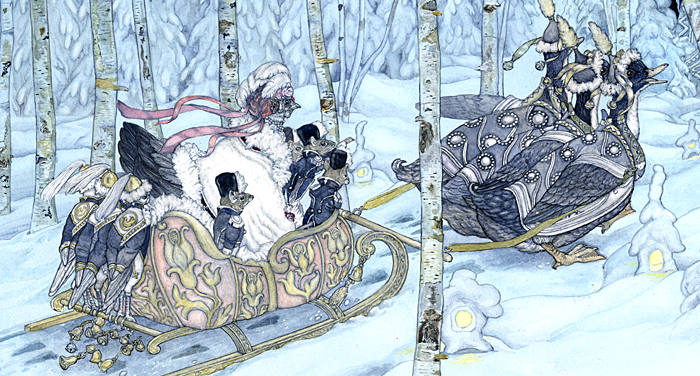
On the way to the ball!
Happy February!
Every month I mark the first day by gathering my thoughts about what I’m accomplishing as a children’s author and illustrator, and what’s next! I put in an exclamation point because I am full of a lot of bottled up energy about CINDERS, the book I’m just finishing, and the coming year’s book project.
I have one and 1/2 double page spreads to finish on CINDERS, plus all the corrections and continuity fixes. I work from a dummy, that I make early on in my book building process. Its in sketch form, and I leave many details for when I work on the final paintings. For example, every book has a subtle color palette. In this book I had three elements of color that I knew were going to be influential. One is the white/blue of the ice and snow. It would be in all the outside scenes, the borders, and the interiors of the Ice palace. Then, there is Cinders dress. I wanted her to be light, innocent and bride-like. She would be competing with all the other chickens in their colorful Russian finery, and I wanted her to stand out. I created a dress befitting a princess in white and pink. Then, there is the orange pumpkin. Orange is a more fiery, southern color, and when I saw white pumpkins at Halloween I thought that maybe a white pumpkin would be an option. However, it didn’t ring true when I painted the pumpkin. As a child, the part of the Cinderella story I liked best was the transformation of the mice, pumpkin and rat to coach, footman and coachman. I was especially pleased to think she could ride in a sleigh, it being set in a Russian winter. Since I wanted a connection between the sleigh and pumpkin, I knew it would have to carry the same colors especially orange. In Saint Petersburg, I was lucky enough to see some old Russian sleighs in the museum of Ethnography. So my three colors are white/blue, pink and orange. Two other colors played minor rolls, the dark blue black of the night sky, and the soft yellow of the hay in the chicken house. When the book is about half completed, we (my editor, art director, and designer, Margaret, Cecilia and Marikka) start thinking about the jacket design, probably the most important image in the book. That is when some of the colors that tell the story can be used, and they will add to personality of the book.
I think of myself as an illustrator before being an author, or more accurately, I tell my story in pictures. You can see how colors are like characters, and how I can shape characters by using color. Prince Cockerel, being royal wears purple, and I made sure he was the only character that does except Cinders on the very last page, but then, she’s a princess. At least I hope they got married! Maybe Cinderella’s wedding would be the subject for another book.
Thank you everyone for entering the contest on my website, for a school visit. I will never forget the wonderful people in Windsor, Newfoundland where I visited last spring. Next time I go, I would like to drive and go on the ferry, so I can stop and see things, and go out whale and bird watching. There is one Moose for every 4 people in Newfoundland, so I would hope to see a Moose as well. Windsor is not a large town, so don’t get discouraged about the contest if your community is not large. The website tabulates how many “likes” they have put on the Facebook page.
My husband Joe is working on a video that will show how to draw Cinders, and some of the scenes we saw in Russia and how they were transformed in my studio to become part of a chicken fairy tale. I will also have Cinders (real name Eddie, Prince Cockerel (Elof) and a few other of my poultry stars and starlets to show you. My friend Janet, who raises Silkies, is going to let me have a pair of her beautiful whites. The video should be up by April!
Happy Creating, your friend,
Jan Brett
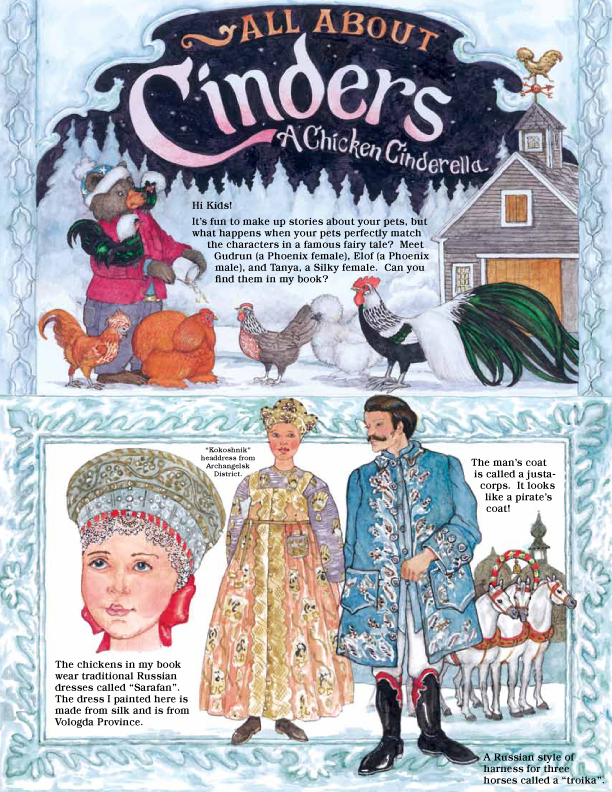
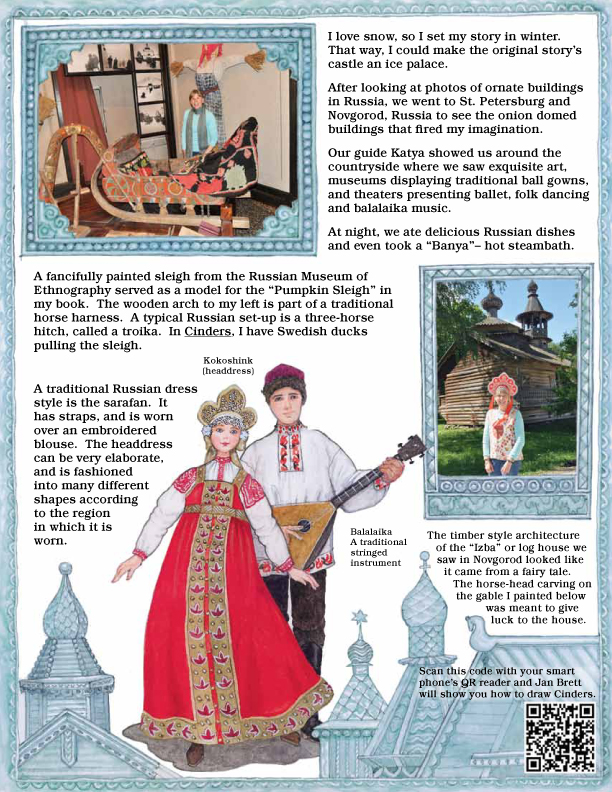
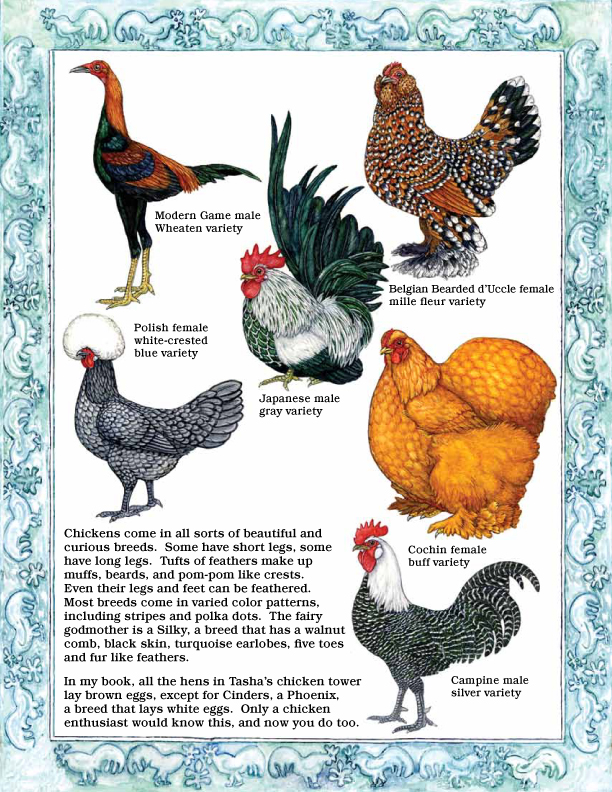
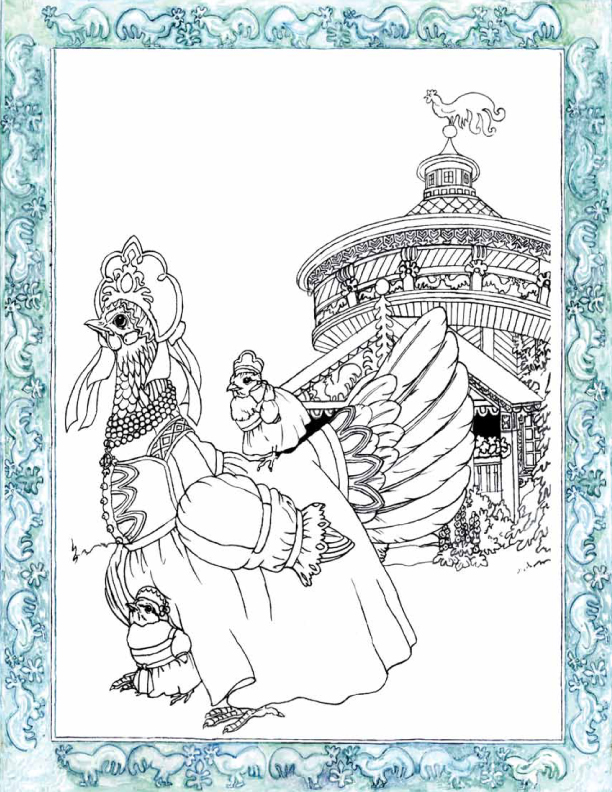
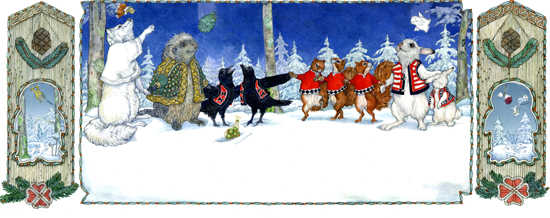
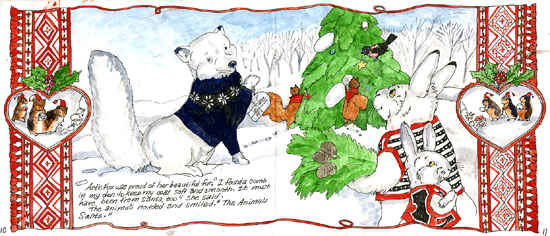
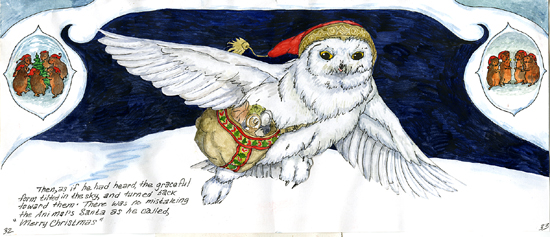
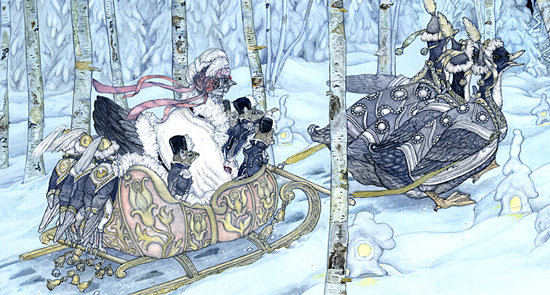
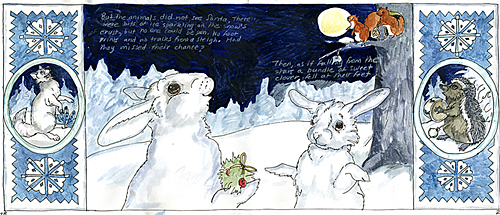
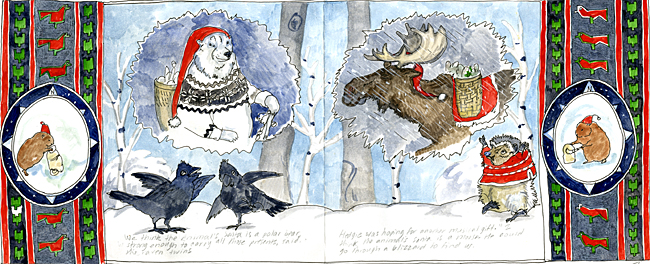
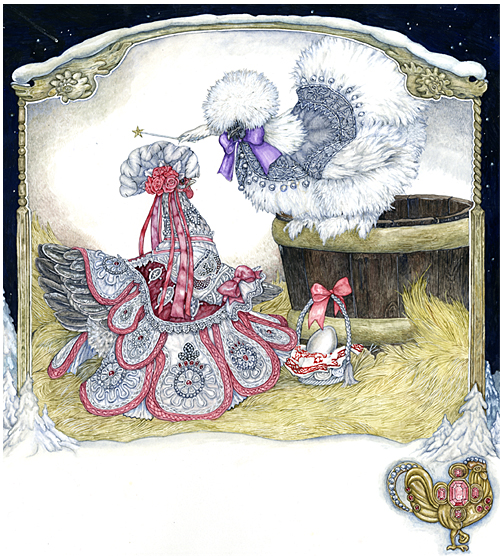
Comments, thanks from Jan Brett